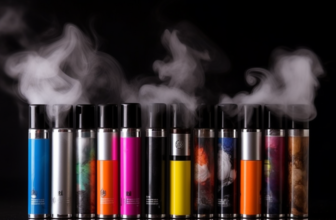
As the popularity of e-cigarettes and vaping continues to rise, it is essential to know how to handle, store, and dispose of vape juice safely. E-liquid safety best practices not only ensure the longevity of your vaping products but also protect the environment and prevent harm to children, pets, and others. This article provides a comprehensive guide on the best practices for e-liquid safety.
Handling E-liquids
When handling e-liquids, it is crucial to follow safety guidelines to avoid accidents. Here are some tips to ensure safe handling of vape juice:
- Wear gloves: To prevent skin contact with e-liquids, especially those containing nicotine, it is advisable to wear gloves when handling vape juice. Nicotine can be absorbed through the skin and cause irritation or other adverse effects. The NHS provides more information on the safety of e-cigarettes and e-liquids.
- Use a syringe or pipette: To avoid spills and ensure accurate measurements, use a syringe or pipette to transfer e-liquids between containers.
- Keep away from children and pets: E-liquids can be harmful if swallowed, especially by children or pets. Store e-liquids in a secure location, and never leave them unattended.
Storing E-liquids
Proper storage of e-liquids is essential for maintaining their quality and preventing accidents. Follow these storage best practices:
- Store in a cool, dark place: Exposure to light and heat can degrade the quality of e-liquids, leading to changes in flavour and potency. Store e-liquids in a cool, dark place, such as a cupboard or drawer, to maintain their quality.
- Keep in airtight containers: To prevent evaporation and contamination, store e-liquids in airtight containers. Ensure that the containers are made from materials that will not react with the e-liquid, such as glass or PET plastic.
- Label containers: To avoid confusion and accidental consumption, label e-liquid containers with the contents, nicotine strength, and other relevant information.
- Childproof caps: To prevent children from accessing e-liquids, use containers with childproof caps. Many e-liquid bottles come with child-resistant caps, but it’s always best to double-check.
Disposing of E-liquids
When it’s comes to disposing of e-liquids, proper methods are necessary to protect the environment and prevent harm to humans and animals. Follow these guidelines for safe disposal:
- Do not pour down the drain: Pouring e-liquids down the drain can contaminate water supplies and harm aquatic life. To protect the environment, avoid disposing of e-liquids in this manner.
- Check local regulations: Different areas have different regulations for the disposal of e-liquids. Consult your local council or waste disposal facility to learn about the proper methods for your area. Gov.uk provides information on recycling collections and waste disposal facilities in the UK.
- Empty bottles: Before disposing of e-liquid bottles, empty them completely and rinse with water. This will prevent accidental exposure to e-liquids during the disposal process.
- Recycle containers: Many e-liquid containers, such as glass or PET plastic bottles, can be recycled. Check your local recycling guidelines to determine the appropriate method for recycling these materials.
Conclusion
Proper handling, storage, and disposal of e-liquids are essential for ensuring the safety of yourself, others, and the environment. By following the best practices outlined in this article, you can enjoy vaping while maintaining a responsible approach to e-liquid safety.




